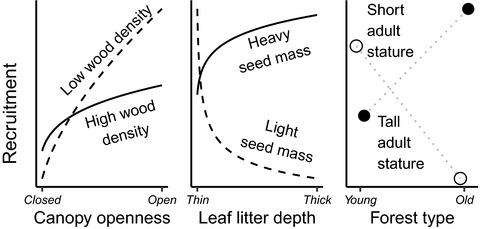Our official English website, www.x-mol.net, welcomes your
feedback! (Note: you will need to create a separate account there.)
Functional traits that moderate tropical tree recruitment during post‐windstorm secondary succession
Journal of Ecology ( IF 5.3 ) Pub Date : 2020-01-08 , DOI: 10.1111/1365-2745.13347 Hao Ran Lai 1, 2 , Kwek Yan Chong 1 , Alex Thiam Koon Yee 1, 3 , Hugh Tiang Wah Tan 1 , Michiel Breugel 1, 2, 4
中文翻译:

在暴风雨后次生演替过程中调节热带树木招募的功能性状
更新日期:2020-01-08
Journal of Ecology ( IF 5.3 ) Pub Date : 2020-01-08 , DOI: 10.1111/1365-2745.13347 Hao Ran Lai 1, 2 , Kwek Yan Chong 1 , Alex Thiam Koon Yee 1, 3 , Hugh Tiang Wah Tan 1 , Michiel Breugel 1, 2, 4
Affiliation

|
- Understanding how functional traits moderate species’ demographic responses along environmental gradients is a core pursuit in ecology, often to predict how species abundances will respond to a rapidly changing environment. The latter necessitates species demography, or at least abundance, to be modelled directly as a response; yet, most studies till date use abundance indirectly to calculate and then correlate community‐aggregated trait indices to environmental variables, rendering the prediction of species demographic responses along environmental gradients unfeasible.
- Using a hierarchical Bayesian approach that stems from joint species distribution modelling, we modelled the recruitments of 53 woody plant species along windstorm‐generated environmental gradients from twenty‐eight 100‐m2 tropical secondary forest plots censused over 5 years in Singapore, and then examined whether environmental responses across species can be explained and generalized by functional traits.
- We found that species recruitment along the light‐availability gradient was moderated by wood density, in that low wood‐density species responded more positively to elevated light conditions by being more responsive in height growth. Seed mass moderated species recruitment along the leaf litter depth gradient, such that large‐seeded species with greater energy reserves recruited more in sites with thicker leaf litter depths than small‐seeded species. Shorter‐ and taller‐statured species recruited more in historically short‐ and tall‐canopied forest sites, respectively, indicating an influence from surrounding parent trees and the importance of considering dispersal limitation in successional studies. Leaf economic traits (specific leaf area, leaf dry‐matter content and lamina thickness) did not moderate recruitment responses across environments, suggesting a weak role of leaf traits during the earlier life stages or their high plasticity.
- Synthesis . Wood density, seed mass and adult stature are the main traits that moderate sapling recruitment in our wind‐generated forest gaps. The roles of multiple traits in moderating the shared environmental responses across species may be crucial in the maintenance of coexistence and diversity through niche partitioning. Most importantly, we estimated the strength and direction of trait effects on species responses to environmental changes during succession. These are potentially generalizable results that can directly predict the demographic responses of any species—given its traits—to environmental changes.
中文翻译:

在暴风雨后次生演替过程中调节热带树木招募的功能性状
- 了解功能性状如何沿着环境梯度缓和物种的人口统计学响应是生态学的核心追求,通常是预测物种丰度将如何对快速变化的环境做出响应。后者需要将物种人口统计或至少人口统计直接建模为响应;然而,迄今为止,大多数研究都间接使用丰度来计算群落聚集性状指数,然后将其与环境变量相关联,从而无法沿环境梯度预测物种人口统计学响应。
- 使用基于联合物种分布建模的分层贝叶斯方法,我们对新加坡进行了5年普查的28个100m 2热带次生林地,根据风暴产生的环境梯度对53种木本植物物种的募集进行了建模,然后进行了研究。是否可以通过功能性特征解释和归纳跨物种的环境响应。
- 我们发现,沿着木材的光密度梯度,沿着木材的光密度梯度的募集受到了木材密度的控制,因为低木材密度的物种通过对高度的增长反应更快,对高光条件做出了更积极的反应。种子质量沿着叶凋落物深度梯度缓和了物种的募集,因此具有较高能量储备的大种子物种在叶凋落物深度较厚的地方比小种子物种吸收了更多的种子。身材矮小和身材高大的物种分别在历史上矮矮的和高檐篷的森林地区中招募了更多的物种,这表明周围亲本树的影响以及在演替研究中考虑扩散限制的重要性。叶片的经济性状(特定叶片面积,叶片干物质含量和叶片厚度)并未缓和整个环境的募集响应,
- 综合。木材密度,种子质量和成年身高是在我们风生林隙中适度吸收树苗的主要特征。多种性状在调节物种间共享的环境响应中的作用对于通过生态位划分维持共存和多样性至关重要。最重要的是,我们估计了性状对演替过程中物种对环境变化的响应的强度和方向。这些是潜在的可概括的结果,可以直接预测任何物种的种群响应(根据其特征)对环境变化的响应。











































 京公网安备 11010802027423号
京公网安备 11010802027423号